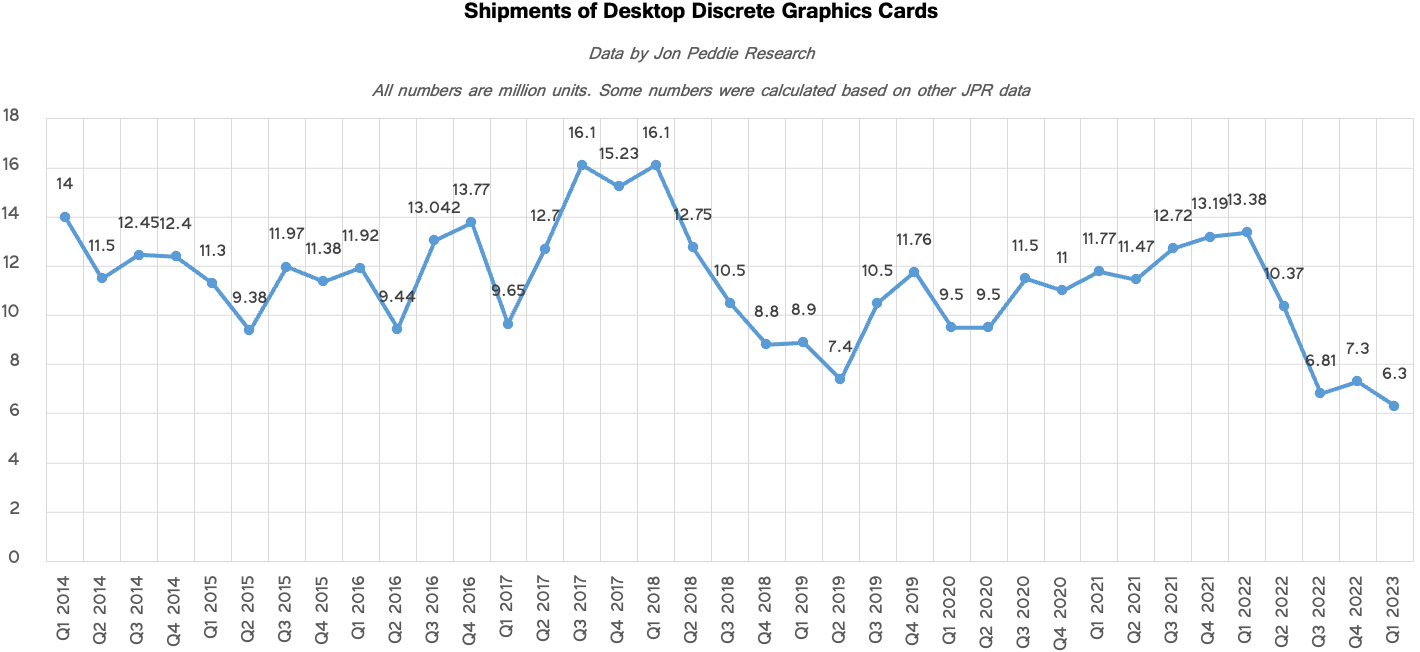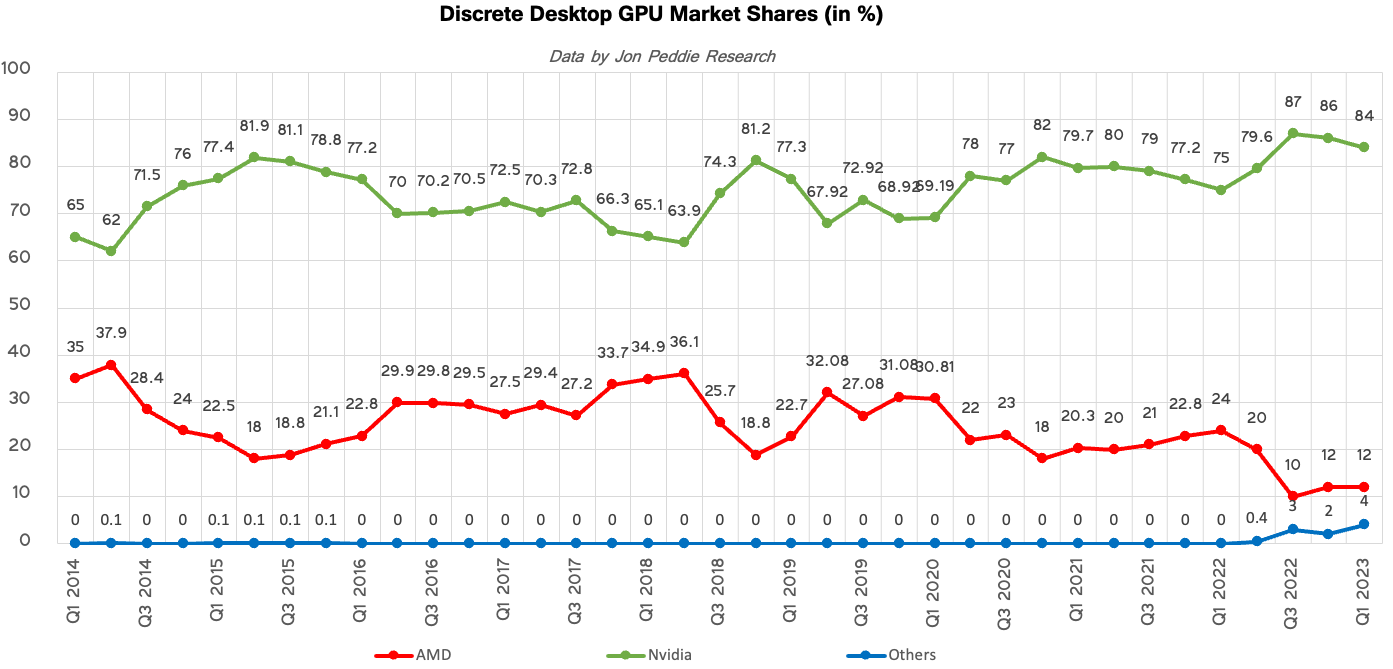Desktop GPU Sales Lowest in Decades: Report
Nvidia continued to dominate in Q2 2023 amid inventory correction, says Jon Peddie Research.

Sales of standalone graphics cards for desktop PCs continued to shrink in Q1 2023 as retailers and PC makers continued to drain their inventory while AMD and Nvidia were prepping to release new generation mainstream add-in-boards (which are set to become some of the best graphics cards), reports Jon Peddie Research. But as the market hit a new multi-decade low, Intel continued to gain share with its discrete Arc Alchemist GPUs and now controls 4% of the market.
Sales of graphics cards for desktops dropped to 6.3 million units in the first quarter, down 12.6% sequentially and 38.2% year-over-year, according to JPR. 6.3 million is the lowest quarterly sales result of discrete graphics cards in decades, as historical data shows.
"Shipments of new AIBs were impacted by a turndown in the PC market due to inflation worries and layoffs, and people buying last-gen boards as suppliers sought to reduce inventory levels," said Jon Peddie, JPR founder and president. "With inventory being run down, sales of new-generation boards will pick up, but not until Q3. Q2 is traditionally a down quarter, and the year won't be any different, but probably not as severe as might be expected."
Nvidia continued to dominate the market with an 84% market share. It supplied approximately 5.29 million discrete graphics processors for desktop computers, its worst result on the desktop market in many years.
AMD was a distant second with a 12% share and 0.76 million AIB units shipped. AMD's Radeon RX graphics cards sales for desktops have been below one million units per quarter. Still, given that PC makers and the channel have been depleting inventory in the first quarter, AMD's rather mediocre results are not surprising.
Unlike Nvidia and AMD, Intel, which launched its Arc Alchemist A700-series graphics cards in late Q3, was ramping up shipments of these GPUs in Q1. This is why it increased sales and gained some share. Of course, Intel's unit shipments were around 250,000 graphics processors, which is incomparable to Nvidia's 5.29 million, but it is evident that Intel's shipments of standalone AIBs are growing.


"Q1 2023 saw the AIB market still facing the consequences for oversupply in the market caused by pandemic-era supply chain inconsistencies and orders," noted C. Robert Dow, analyst at JPR. "The second half of 2023 promises to be brighter. AMD reported that channel sales grew sequentially for the Radeon 6000 and Radeon 7000 series GPUs. Intel, once again, committed to their next-generation Battlemage family of GPUs, bringing more competition into the gaming add-in board market, and Nvidia released its first 60-series add-in board in the Ada Lovelace family. The 60-series line of AIBs are traditionally Nvidia’s most popular with gamers."
Get Tom's Hardware's best news and in-depth reviews, straight to your inbox.

Anton Shilov is a contributing writer at Tom’s Hardware. Over the past couple of decades, he has covered everything from CPUs and GPUs to supercomputers and from modern process technologies and latest fab tools to high-tech industry trends.
-
kanewolf I wonder how much the improvement of integrated graphics has impacted this. Even the "grandparents" rig required some graphics card for many years. Now both AMD and Intel have integrated graphics that will handle mom/pop and office tasks with ease.Reply -
spoidz I am still using a RTX 2070 Super with an otherwise very strong system (9900KS 5Ghz CPU). I try to buy the strongest GFX I can when I can afford to and making my next major platform leap. I just don't buy a new GFX Card every generation so I guess I'm part of the drop.Reply -
Eximo Reply
Immensely so, we see it in the desktop product stack already. GT1030 or RX550 being the lowest relatively current GPUs you can still get new. With HD730 and Vega / RDNA based integrated graphics, not much call for anything more.kanewolf said:I wonder how much the improvement of integrated graphics has impacted this. Even the "grandparents" rig required some graphics card for many years. Now both AMD and Intel have integrated graphics that will handle mom/pop and office tasks with ease.
People complain that the entry level desktop gaming GPUs are too expensive, but that is because if they made cheaper ones, they would then be seen as too weak to justify the costs. That has always been the case. Just more so now.
$90 for a 2GB GT1030, or $90 for the 4GB RX550. People shouldn't be buying GT730 for $60 (Actually is an r7-240 for $35 right now, neat)
Or $95 for a 3200G.
$121 for a 5600G -
dennphill For one who was sorta ‘burned’ at my last build (during tough ‘mining heydays and ‘bots picking up any then-current cards), that being mid-2021, I am probably typical in being both hesitant to buy any recent GPU offerings or, moreover, hesitant in doing any desktop upgrades (much less new build)! Card I (finally!) got was a PowerColor Red Devil RX6700XT that cost me over a Grand at the time! I was only lucky after a month or two of searching to finally grab one off Amazon for that price to complete a then-new build. That card (and build AM4 Ryzen 7-5800X3D) is working just fine, and suits my only-occasional gaming needs. Good article, Anton…just one old codger’s reaction to its content: I can very easily understand the public’s lack of interest in the recent Nvidia and AMD GPU offerings!Reply -
I bought the 1080 Ti for $699 as part of my 7700k build in 2017.Reply
$1500 for the 3090 as part of my 10900k build in 2021. Sold the 1080 Ti for $250.
$1750 for the 4090 as part of my 7950x3D build in 2023. Sold the 3090 for $750.
We'll never see a flagship card for $699 again... and while I am not a Nvidia shareholder I do believe that the 4090 is worth the premium. It's a quantum leap in performance improvement over the 3090 as shown here.
https://www.3dmark.com/compare/pr/750873/pr/2386864
.... and here.
https://www.3dmark.com/compare/fs/24586651/fs/30194154
You are getting what you pay for with the 4090.
Change my mind. -
Eximo Reply
I don't disagree, lower prices would be better, but that isn't what I am getting at.saunupe1911 said:We are either broke or refuse to upgrade those prices!
Minimum cost to make a graphics card, and you wouldn't want to buy the minimum anyway because its performance would be worse than what you have now in all likelihood.
Take a look at the 4060Ti, new generation, same performance as last gen. A bad purchase.
But you also wouldn't want to buy a 4050 with 4GB of memory because a 3050 with 8GB is going to be superior and cheaper for now. So if 8GB is the new entry level for gaming and there is a market for it, they will make it. There isn't much of a market for sub $200 gaming GPUs because of integrated graphics overwhelmingly filling that role. Everyone else looking for a card that cheap is basically satisfied with previous generation products. -
ReplyEximo said:
Take a look at the 4060Ti, new generation, same performance as last gen. A bad purchase.
I'm not sure why Nvidia made the 4090 the only respectable card in the 4000 series... to drive sales I guess. -
Eximo ReplyTravisPNW said:I'm not sure why Nvidia made the 4090 the only respectable card in the 4000 series... to drive sales I guess.
Yes and no, they expect sales to be good for Halo products. High end products have a much smaller base and the mid-range cards have the bigger audience. I think the 4060Ti is a cost compromise.
They screwed up the 4080 by making it a bad deal. As others have mentioned before, the 4080 should have been a 20GB cutdown 4090. And the 4070/Ti should have been 4080.
When they tried to pull off the 4080 12GB, that was the sign things were going to go poorly. -
ReplyEximo said:
When they tried to pull off the 4080 12GB, that was the sign things were going to go poorly.
Yeah I understand the frustration people are having. Nvidia could have done lot better.
Am I surprised sales are low? Not really. When an entry level card today costs as much as a flagship from 6 years ago that says it all IMO.
I would love to know Nvidia's profit margins... especially on the 4090. I honestly have no idea what their cost is.

